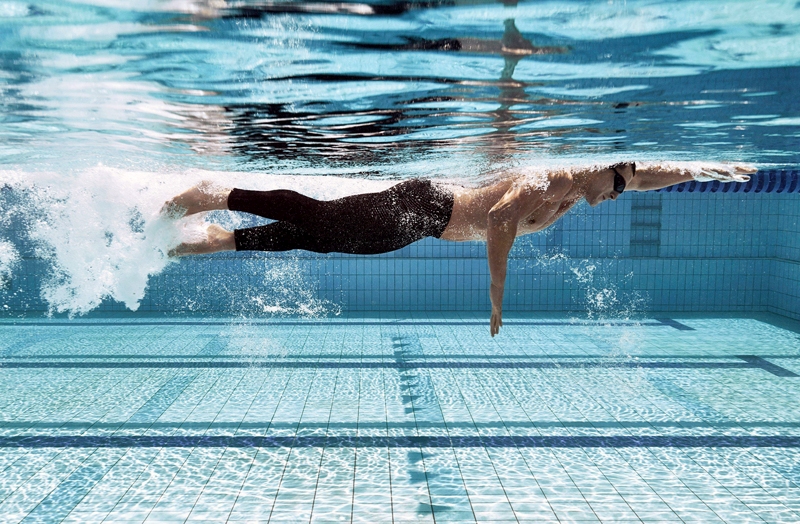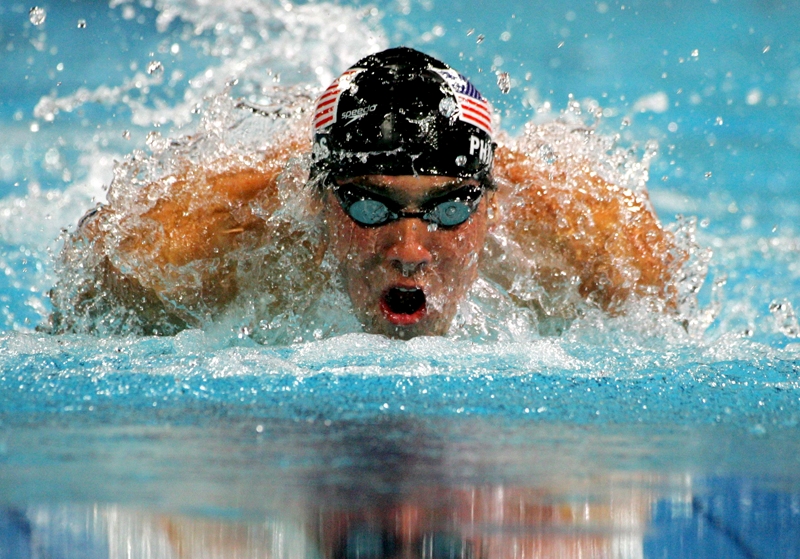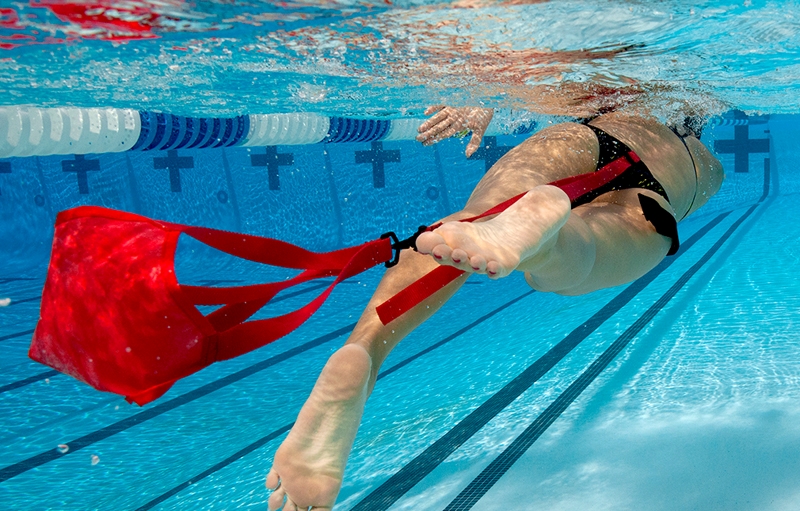You are viewing 1 of your 1 free articles. For unlimited access take a risk-free trial
Swimming technique: why core values matter!
John Wood explains how posture and core control can influence swimming performance, and what this means for swimmers seeking faster times
Many athletes complain that swimming is ‘really hard work’ for them. In particular, a large number of triathletes experience frustrations about sinking legs – unless they are swimming in a wetsuit. There is an explanation of course; triathletes tend to have very dense legs, containing a lot of muscle tissue as a result of cycling and running training. Muscle is denser than water, and combined with low levels of body fat (less dense than water), this means that the legs can tend to drift downwards in the water. When the legs drift downwards in the water, drag is increased meaning more energy is expended to maintain a given speed (see figure 1). However, there’s another problem with ‘sinking legs’, which is when the hips and legs sink lower in the water and the load on the shoulders is greatly increased. This tends to result in swimmers forcing their arms to pull through the water – an action that uses smaller muscle groups and results in a far less efficient position from which to generate power. Furthermore, poor body position in the water can lead to shoulder and spinal muscle injuries if training loads are highPollard H, Fernandez M. Spinal Musculoskeletal Injuries Associated with Swimming. A Discussion of Technique. Australas Chiropr Osteopathy. 2004 Nov; 12(2): 72–80.FIGURE 1: FRONTAL DRAG AND LEG POSITION
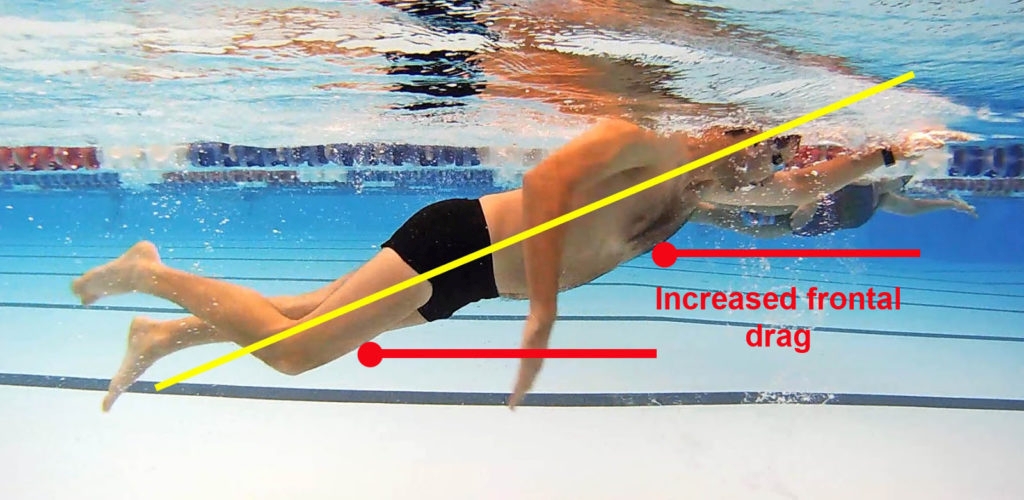
Core, posture and position
Until around ten years ago, the majority of coaches were encouraging their swimmers to ‘look forwards’ when swimming freestyle, with common coaching cues such as ‘keep your hairline at the surface of the water’. More recently though, many of these coaches have changed to encouraging swimmers to look toward the bottom of the pool; however this doesn’t necessarily address the whole body position issue. Instead, a strong swimming posture is the key to getting this right.Good body positioning in the water is extremely important in swimming because moving through the water efficiently doesn’t come naturally to humans! Pick up any mainstream magazine on sports and health, and you’ll find plenty of articles claiming that performing core strength training is the real key to improving health, injury prevention and performance. Unfortunately however, very rarely does this strength work cross over effectively into any sport unless you are aware of how to use itSantana JC. Strength Training for Swimmers: Training The Core. Strength and Conditioning Journal; Lawrence27.2 (Apr 2005): 40-42..
Growing up as a child – and at other various points in your life – it’s likely you have been told to ‘stand up straight’ or ‘not to slouch’. That same advice can also be carried into the water, because your swimming posture significantly affects body position. Posture can also influence the likelihood of neck/back pain – and possibly more importantly, your power output. Indeed, the mantra ‘swim proud’ is one that is appropriate to all swimmers!
The concept of core stability in swimming refers to the ability of the muscles of the trunk to keep the spine and hip girdle functioning as a single unit during movement. This means that the limbs can then act with increased efficiency because they’re not trying to assist in stabilising movementAbt JP, Smoliga JM, Brick MJ, Tolly JT, Lephart SM, Fu FH. Relationship Between Body Mechanics and Core Stability. Journal of Strength and Conditioning Research, 2007, 21 (4), 1300-1304..
Most swimmers have far stronger and more able core muscles than they realise; however, many are not used to using them or feeling the benefits of them. In an ideal world (and with most top swimmers), the hips and shoulders should rotate in tandem, and should function as a single unit throughout for best power generation and body positioning. Unfortunately, the evidence suggests that slower/weaker swimmers tend not to use their hips much if at all – instead tending to rely purely on shoulder power throughoutPsycharakis SG, Sanders RH. Body roll in swimming: A review. Journal of Sports Sciences, 28(3) (2010) 229-236.
The ability of a swimmer to use his/ her core muscles helps lift the body in the water by creating tension in the body, and maximising the use of the lungs for flotation. From this enhanced body position – ie higher in the water – the core muscles can then control rotation, allowing the bigger muscles of the back such as the latissimus dorsi to provide power rather than relying on the relatively small deltoid muscles of the shoulder (see figure 2). It is the latissimus muscles that give elite swimmers the iconic triangular shape, and something that many age-group triathletes miss; instead focusing on dragging themselves through the water inefficiently from the shoulder.
FIGURE 2: LATISSIMUS AND DELTOID MUSCLES
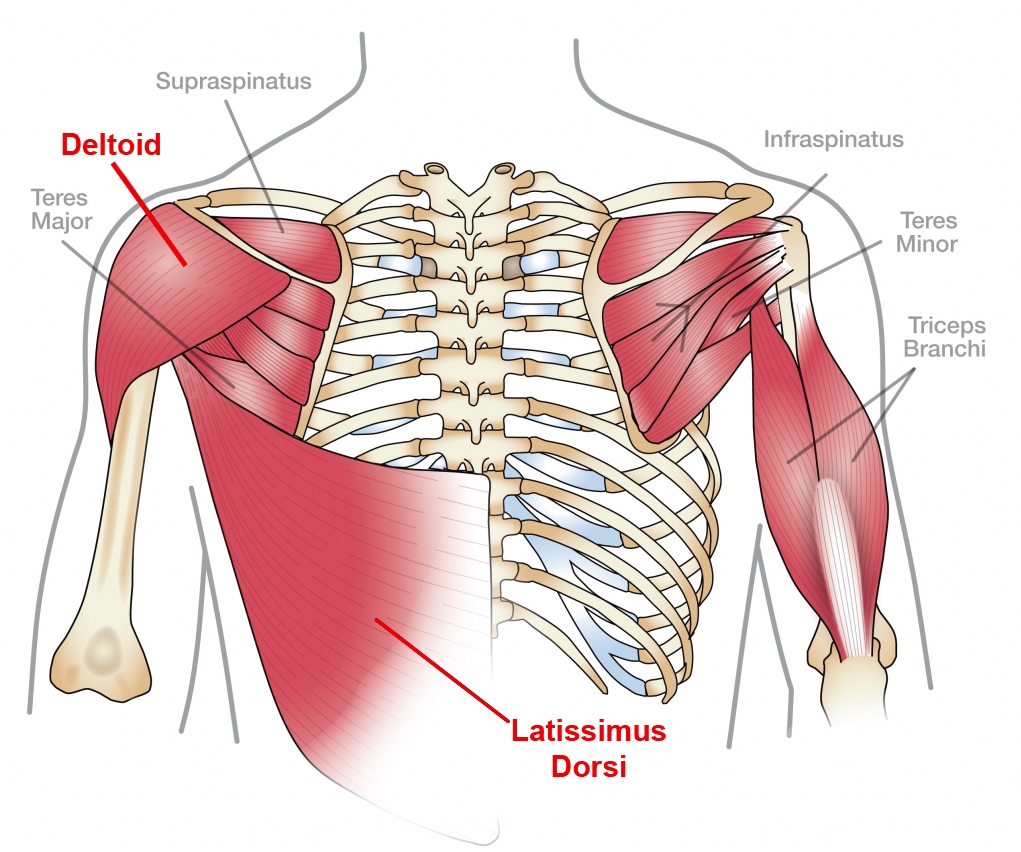
Drills and exercises to improve core control
Given the importance of developing core strength to ensure the hips and upper body function as a single power generating unit, improving core function with targeted drills and exercises can significantly improve swimming performance (see case study later). Here are some examples:*Deadman float – This is a really useful drill to establish how your body sits in the water, and to start to gain awareness of the water around you. To perform this drill, relax and let your body go floppy in the water (this is where we get the name of the drill!). The likelihood is that your legs and arms will hang down. Now repeat the drill but lengthen your neck/spine (cue: pull ears away from shoulders), engage your core (cue: belly button toward your spine, squeeze glutes/hamstrings) and raise your arms forward so that your ears are between your biceps. Fingers crossed, your legs should start to lift up in the water. If you are really lucky you will end up floating in a fairly horizontal position on the surface (see figure 3)! This is your starting position to work from – in this position, everything that you do will generate forward movement with minimal frontal resistance.
FIGURE 3: DEADMAN FLOAT
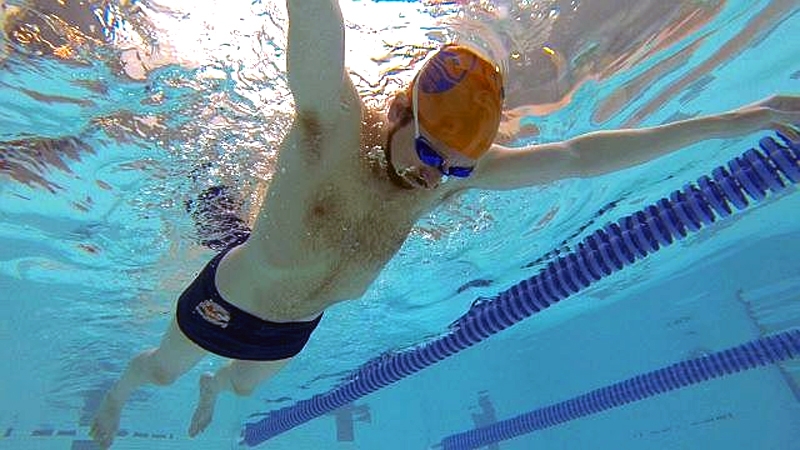
*Side kicking – This is a good way of nailing body position and a balanced kick at the same time (see figure 4). It forces you to kick up and down – or in this orientation forwards and backwards. Try this: swim with your right arm extended, 3-4 inches below the water. Keep your left arm by your side, and twist your body from your hips to face your left hand side. Ensure that your hand is pointing where you want to go (it’s acting as your rudder). My preference is to get athletes looking down here, as it will help keep the hips high, and then all you need to do is turn your head/neck to breathe. The real benefit of this as a drill is that it ensures that you keep your spine straight, and shoulders and hips parallel without any twisting.
FIGURE 4: SIDE KICKING DRILL
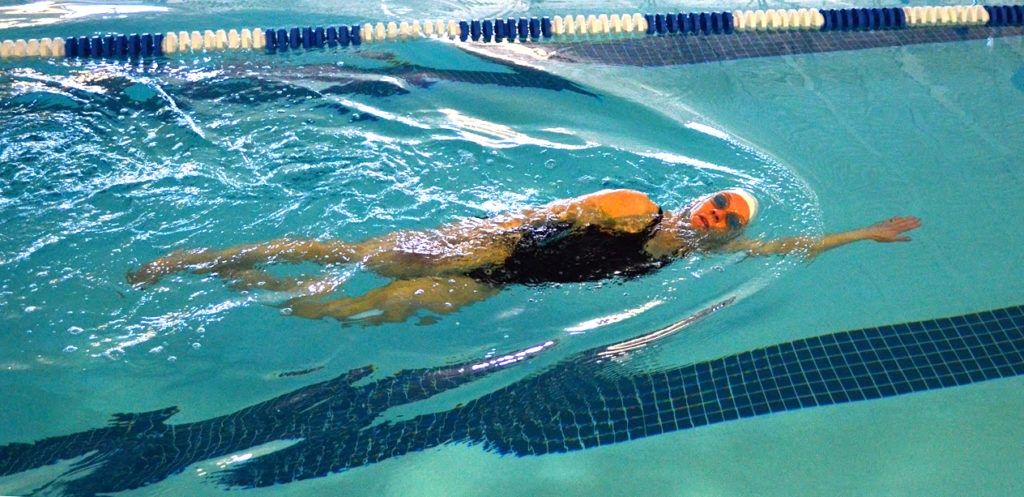
*Rotator kick - This is a favourite drill of mine because it forces you to think about what you are doing, and not to go on autopilot! If your core is not engaged or switched on, your hips will sink and then when you try to rotate round to one side it will make life far more difficult and breathing much more challenging. Kick with your arms by your sides and looking downward. After 6 kicks twist your hips 90 degrees so that your body is facing sideways. This is the important bit – if your shoulders twist, your hips may not follow. However, rotating from the hips rotates the torso evenly. Once you are on your side, you can take a breath. Do six kicks and return to a lying flat position. Repeat on alternate sides.
*Pull buoys – Many athletes use pull buoys as a safety blanket to lift their hips up in the water, rather than sorting out the root cause of this issue. However they can be a useful tool to help reiterate and confirm good body position. By alternating between swimming with a pull buoy and without, you can aim to maintain the same position in the water more of the time. To make things more challenging, rather than using the float between your thighs as per usual, try moving it lower so that you hold it between your knees, or even your ankles. The lower position of the pull buoy will change your centre of balance, and this will cause your hips to swing from side to side. To prevent this, you will need to think about maintaining control of your core.
Dryland exercises
Paloff press – This is performed with a cable machine in the gym, or a stretch chord/Theraband. Step away from the machine with your shoulder facing the anchor point, elbows tucked into your sides bent at 90 degrees and hands in front of your stomach. Push the hands forward and away from your body resisting the pull of the cable trying to twist you sideways. Return your hands to the starting position and repeat (see here for a good video tutorial: www. youtube.com/watch?v=nFspBRHke4w). An alternative to this exercise is to hold the starting position and side step, crab like, away from the anchor point – again resisting the pull and any tendency to twist the body – then return back to your starting point. A push up plank is a great core and anti rotation exercise that you can do at home, with no equipment required. Start in a standard plank position – but with your forearms pointing inward rather than forward (it’s better for shoulder stability). One arm at a time, extend up into a push up position. But here’s the catch - as you do push up, keep your hips level with your shoulders as opposed to letting them twist and fall all over the place. You can find a tutorial for this exercise here: www. youtube.com/watch?v=1Ky2anWlEUs. Remember that working across these drills will be about making a change to the foundations of your swim stroke. It may take a little time at first, but ultimately it can reap great rewards both in terms of speed and efficiency.Case study: Gareth Jones
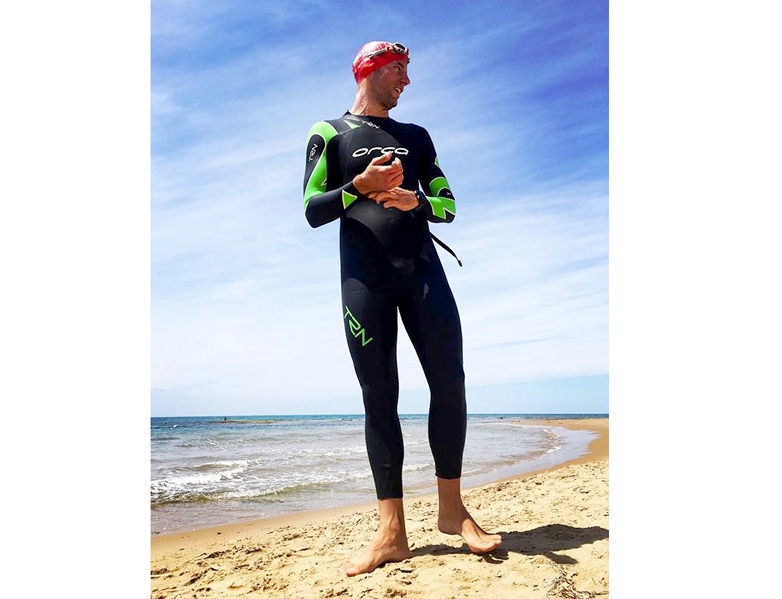
Gareth is a good quality club runner who came to triathlon in his 30s, having not really done any swimming before. Despite having a good cardiovascular ‘engine’, and having good upper body strength, his swim speed didn’t reflect anything like his fitness or the effort being put in; he was averaging well over 2 minutes for each 100m covered in the water.
Working towards the Ax Triathlon first, and then the Brutal Ironman Triathlon, we set about levelling him out in the water to help reduce his frontal resistance. We also wanted to better ‘connect’ his upper body to his lower body in terms of his stroke, as analysis shows that they tended to work as two separate entities rather than a combined whole.
Up until this point, Gareth had done a lot of work relying on using a pull buoy to help him get through training sessions. So we spent some time weaning him off the leg float as a prop, instead encouraging him to use it as a tool in order to help him improve his body position. Using some of the drills outlined above to help focus Gareth on using his core and create some body tension, he was able to start keeping his hips closer to the surface of the water (minimising the resistance and making swimming easier). In addition, he was able to start using the lats of his back more efficiently to generate force under the water. This combination gave Gareth a double-whammy effect – reduced resistance and increased power.
Having done some work on encouraging Gareth to use his core more while swimming – floating and kicking to help improve posture and body position – we worked on using his pull buoy as a tool to help retain his position rather than as his crutch. As result of these changes over 6 months, he was swimming 30 seconds per 100m faster – and with less effort and fatigue.
In last year’s Brutal Triathlon, the swim ended up being 4.5km as opposed to 3.8km, and Gareth still came out of the water in a very respectable 1 hour 15mins (averaging 1min.40sec per 100m) before coming 17th overall. Since that race, we have been working on extra tweaks and changes so that he can achieve a time of under 10 hours for a standard long distance race. This will require Gareth to swim 3.8km in under an hour, which will mean working on generating more power under the water.
Newsletter Sign Up
Testimonials
Dr. Alexandra Fandetti-Robin, Back & Body Chiropractic
Elspeth Cowell MSCh DpodM SRCh HCPC reg
William Hunter, Nuffield Health
Newsletter Sign Up
Coaches Testimonials
Dr. Alexandra Fandetti-Robin, Back & Body Chiropractic
Elspeth Cowell MSCh DpodM SRCh HCPC reg
William Hunter, Nuffield Health
Keep up with latest sports science research and apply it to maximize performance
Today you have the chance to join a group of athletes, and sports coaches/trainers who all have something special in common...
They use the latest research to improve performance for themselves and their clients - both athletes and sports teams - with help from global specialists in the fields of sports science, sports medicine and sports psychology.
They do this by reading Sports Performance Bulletin, an easy-to-digest but serious-minded journal dedicated to high performance sports. SPB offers a wealth of information and insight into the latest research, in an easily-accessible and understood format, along with a wealth of practical recommendations.
*includes 3 coaching manuals
Get Inspired
All the latest techniques and approaches
Sports Performance Bulletin helps dedicated endurance athletes improve their performance. Sense-checking the latest sports science research, and sourcing evidence and case studies to support findings, Sports Performance Bulletin turns proven insights into easily digestible practical advice. Supporting athletes, coaches and professionals who wish to ensure their guidance and programmes are kept right up to date and based on credible science.
